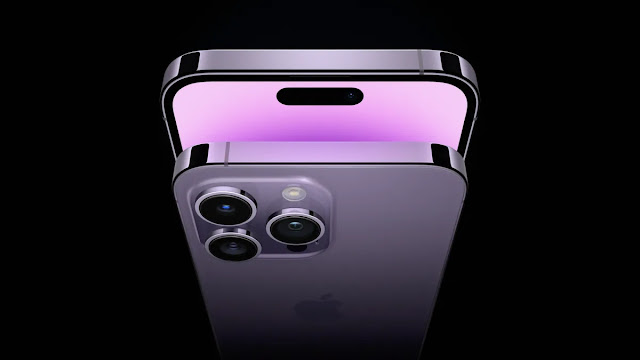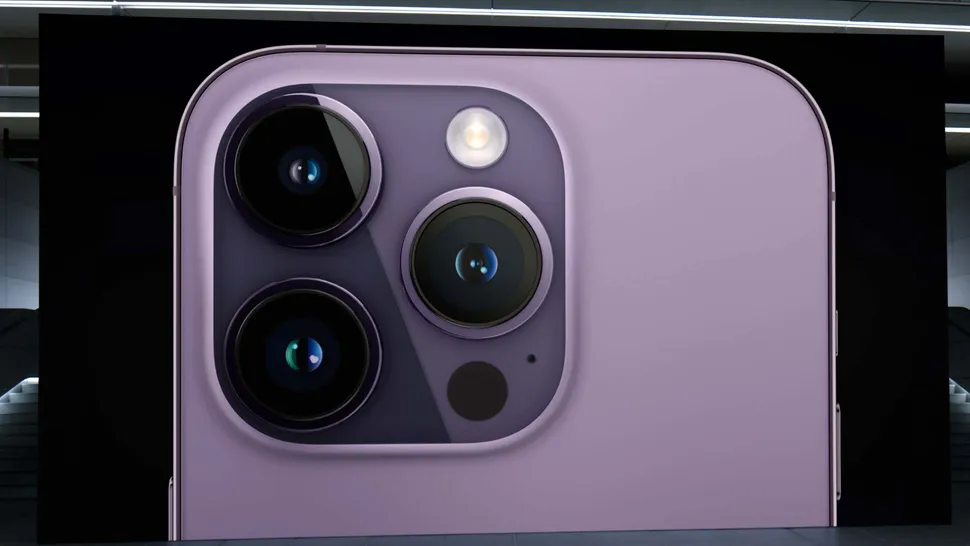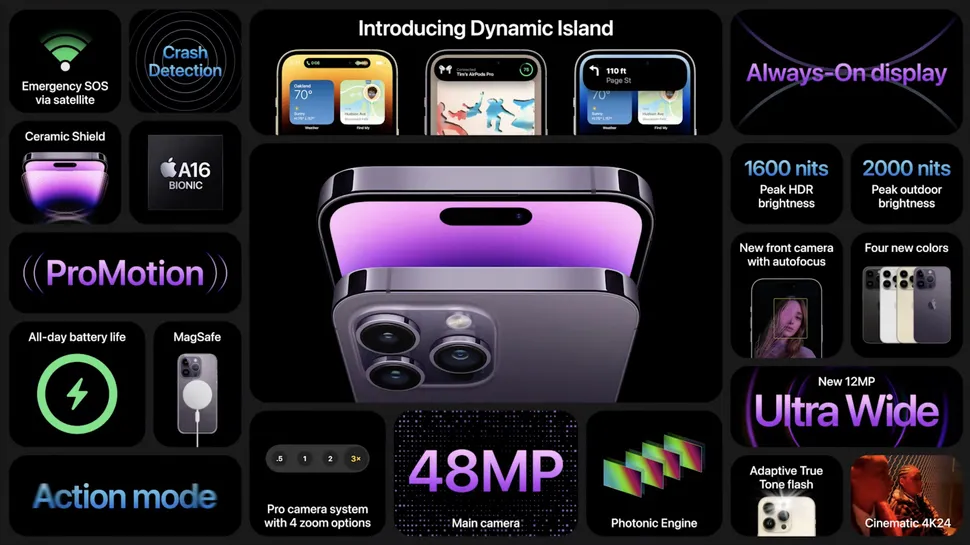Here's everything you need to know about the iPhone 14 Pro and iPhone 14 Pro Max
Update: Our iPhone 14 Pro Max hands-on review is live. See our first impressions!
After months of leaks and speculation, Apple has finally revealed the iPhone 14 Pro and iPhone 14 Pro Max at the September Apple event. And this pair of iPhones bring in some significant changes.
Not only is the infamous display notch finally gone, but the iPhone 14 Pro also sports a new 48-megapixel main camera, new A16 Bionic chip, and other improvements. In fact, we’d say this is one of the most notable iPhone Pro updates in some time, and offers a lot more than the standard iPhone 14 or iPhone 14 Plus.
So read on for everything you need to know about the iPhone 14 Pro.
iPhone 14 Pro cheat sheet: everything that’s new
- The notch is dead and in its place is a pill-shaped cut-out to house the Face ID sensors and front-facing camera.
- This cut-out is called the “Dynamic Island” that changes size depending on alerts, like calls or Face ID use, AirPods on charge and background activity.
- The new display is now brighter at 1,600 nits and has slimmer bezels. And peak brightness tops out at 2,000 nits for use in sunlight.
- There's now an Always-on display, enabled thanks to new tech that allows for refresh rates as low as 1Hz, as well as a new LTPO panel to seriously dim the screen for low-power mode.
- A new A16 Bionic chip mixes the power of 16 billion transistors with efficiency. It's built on a 4-naonmeter process, with a 6-core CPU that beats the A15 Bionic, yet sucks up less power than the competition; think the Snapdragon 8 Gen 1. There's a 5-core GPU more with 50% more bandwidth and a display engine to power the Dynamic Island. The Neural Engine can now handle 17 trillion operations per second to help aid computational photography.
- A new 48MP camera promises more detail-rich photos and improved low-light photography, with up to 2x performance than the iPhone 13 Pro, thanks to Apple's new Photonic Engine. ProRAW can also be used with uncompressed 48 megapixel photos, enabling more editing flexibility for adjusting white balance and tone mapping.
- All three cameras (main, telephoto, ultrawide) all get improved low-light photography. A new flash with 9 LEDs helps facilitate this.
- For video, there's 4K resolution up to 40 frames per second for Cinematic mode, and the new action mode is put to use for improved video stabilization.
- Apple promises an "all day battery life."
- There's also crash detection so the iPhone 14 Pro can automatically call emergency services if it detects you’ve had a crash.
- The iPhone 14 Pro still starts at $999 (AU$1,749) and iPhone 14 Pro Max at $1,099 (AU$1,899), with pre-orders coming September 9 and a full release on September 16.
iPhone 14 Pro release date
The iPhone 14 Pro and iPhone 14 Pro Max will go on sale September 16.
But those keen to get a head start on the crowds can pre-order both iPhone 14 Pro models on September 9.
Also thanks to T-Mobile US customers can save up to $1,000 on an iPhone 14 Pro if you trade in your old phone. In effect, you could get the base iPhone 14 Pro for free.
iPhone 14 Pro price
Despite rumors of a price increase, the iPhone 14 Pro and iPhone 14 Pro Max will stick at starting prices of $999 (AU$1,749) and $1,099 (AU$1,899) respectively.
For the upgrades on offer, this seems rather generous for Apple. But sadly the starting storage is still stuck at 128GB, which some may find is a little constrained.
Both phones come in a selection of four colors: Space Black, Silver, Gold, and a new Deep Purple.
iPhone 14 Pro specs
| iPhone 14 Pro | iPhone 14 Pro Max | |
| Screen size | 6.1-inches | 6.7-inches |
| Refresh rate | 1-120Hz | 1-120Hz |
| CPU | Apple A16 Bionic | Apple A16 Bionic |
| Storage | 128GB, 256GB, 512GB, 1TB | 128GB, 256GB, 512GB, 1TB |
| Cameras | 48MP main, 12MP ultrawide, 12MP telephoto with 2x optical zoom | 48MP main, 12MP ultrawide, 12MP telephoto with 2x optical zoom |
| Colors | Space Black, Silver, Gold, Deep Purple | Space Black, Silver, Gold, Deep Purple |
iPhone 14 Pro design and display
Well it appears all the leaks and rumors were true: Apple finally killed the display notch with the iPhone 14 Pro and iPhone 14 Pro Max. In its place is a single pill-shaped display cut-out.
Given many of the best Android phones make use of single punch-hole camera cutouts, you might think a pill shape would look dumb. But there's enhanced functionality here in the form of the Dynamic Island.
That's the fancy name Apple has given the cut-out that can seemingly expand, via software and graphics, to communicate a range of alerts, from confirming AirPods are connecting correctly to showing the phone has started charging and expanding to indicate certain background activity; it becomes an island for when music is playing.
As for the display itself, the sizes remain at 6.1 inches and 6.7 inches for the iPhone 14 Pro and iPhone 14 Pro Max respectively.
But not only are the bezels slimmer, a new LTPO panel is used to enable a refresh rate to scale down from 120Hz to 1Hz. By doing this battery life can be saved even when enabling the new Always-on display, which can show notifications and information even when the phone is locked, all without raising the iPhone or tapping the display.
And for people who like watching things like moves on their iPhones, the iPhone 14 Pro and iPhone 14 Pro Max can now hit 1,600 nits of brightness, with a peak brightness of 2,000 nits for outdoor use. That's brighter than the mighty Samsung Galaxy S22 Ultra.
The rest of the design for the iPhone 14 Pro and iPhone 14 Pro Max is broadly similar to the iPhone 13 Pro and iPhone 13 Pro Max. The edges remain flat and are made of stainless steel as before.
iPhone 14 Pro cameras
As predicted by the rumors, the iPhone 14 Pro and iPhone 14 Pro Max both got new 48-megapixel main cameras.
At a base level, these will enable higher resolution photos with more detail and better low-light photography. But there's more to this than a simple specs boost.
With a quad-pixel sensor, the new main camera combines four pixels into one large quad pixel equivalent to 2.44 µm, and allows for the sensor to adapt to the photo being captured. So while photos will, by default, be resolved a manageable 12MP, there's scope to capture more detail and let in a lot more light.
To really hammer home the 'pro' element of the new Pro iPhone, the ProRAW mode can now capture uncompressed 48MP photos to enable a lot more editing potential. And for video fans, the 48MP camera allows for 4K at 30 frames per second in Cinematic mode; sadly no 8K video capture on offer here.
Second-generation sensor-shift optical image stabilization and the smart processing of the A16 Bionic chip's Neural Engine (more on that later) provides a new Action Mode for video stabilization when moving at speed across difficult terrain.
The 48MP camera also enables a new 2x zoom mode by using the middle 12 megapixels of the main sensor for full-resolution photos and 4K videos with no digital zoom.
While the ultrawide and telephoto cameras stick at 12MP, they have been improved. The telephoto camera still hits 3x optical zoom but comes with a 6x optical zoom range. And the ultrawide camera is new making use of 1.4 µm pixels for sharper images and an improved macro mode.
The new 12MP TrueDepth front-facing camera comes with an an ƒ/1.9 aperture that enables better low-light performance for photos and video, and also gets autofocus for the first time. This should allow for better low-light photo capture and for improved shots of groups from further away.
On the computational photography side, Apple has the new Photonic Engine that promises better mid- to low-light performance across all three cameras; a 2x boost to the main camera, 3x on the ultrawide and 2x on the telephoto camera, as well as a 2x improvement on the front-facing camera.
Building on Apple's Deep Fusion AI tech the Photonic Engine will apparently process more detail in photos while preserving subtle textures, providing better color, and maintaining more information in a photo.
On top of all this, a new "Adaptive True Tone flash" makes use of nine LEDs to better adapt to lighting conditions and further boost low-light photography.
iPhone 14 Pro chipset and battery life
The iPhone 14 Pro and iPhone 14 Pro Max both get the new A16 Bionic chip. Building upon the already fast A15 Bionic, the 6-core CPU is up to 40% faster than the competition (think Qualcomm's Snapdragon 8 Gen 1). Yet being built on a 4-nanometre process and sporting 16 billion transistors, the chip's two high-performance cores consume 20% less power than before.
The 5-core GPU offers 50% more bandwidth, which should deliver more gaming performance and slicker graphically intensive apps. And a display engine has been added into the mix to take care of the Dynamic Island.
But iPhones have never lacked in performance, so the interesting thing here is the Neural Engine can now handle 17 trillion operations per second and 4 trillion operations per photo. Working in tandem with the image signal processor, it should mean the iPhone 14 Pro's computational photography skills end up being very impressive.
Apple revealed no battery sizes but promised the iPhone 14 Pro and 14 Pro Max will deliver "all-day battery life." We'll have to see about that in our testing. Fast charging is on offer with a 20W adapter filling up the battery to 50% in around 30 minutes.
There was no mention of RAM, either capacity or type, but expect the iPhone 14 Pro and 14 Pro Max to be blazingly fast. Storage will come in 128GB, 256GB, 512GB and 1TB options.
iPhone 14 Pro outlook
What may have seemed like incremental upgrade at a quick glance, the changes here could all add up to make for a substantial iPhone update and a contender for our best phones list.
The Dynamic Island might sound a bit odd, but it could set the standard for how display cut-outs and notches can be used as a feature rather than a necessary inconvenience. And with third-party support, the new alert feature could be used for all matter of smart purposes.
Then there's the 48MP camera. While Android phones are no stranger to high-megapixel sensors, the use of Apple's computational photography at a hardware and software level could really set a new standard for the best camera phones.
Of course, we'll need to test the iPhone 14 Pro and iPhone 14 Pro Max for ourselves before drawing any conclusions. In the meantime check out our iPhone 14 Pro Max hands-on review.














0 Comments